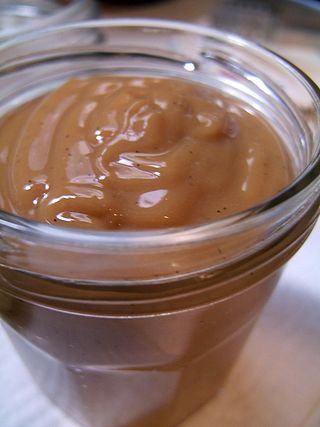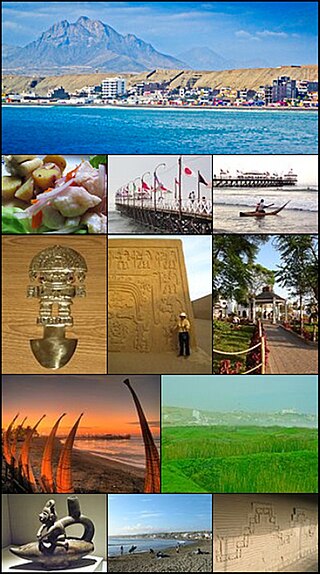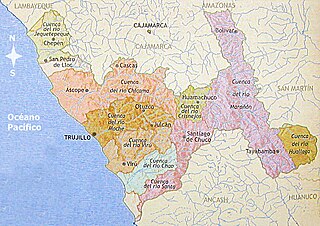Related Research Articles

A chocolate bar or candy bar is a confection containing chocolate, which may also contain layerings or mixtures that include nuts, fruit, caramel, nougat, and wafers. A flat, easily breakable, chocolate bar is also called a tablet. In some varieties of English and food labeling standards, the term chocolate bar is reserved for bars of solid chocolate, with candy bar used for products with additional ingredients.

Trujillo is a city in coastal northwestern Peru and the capital of the Department of La Libertad. It is the third most populous city and center of the third most populous metropolitan area of Peru. It is located on the banks of the Moche River, near its mouth at the Pacific Ocean, in the Moche Valley. This was a site of the great prehistoric Moche and Chimu cultures before the Inca conquest and subsequent expansion.

An alfajor or alajú is a traditional confection typically made of flour, honey, and nuts. It is found in Argentina, Paraguay, the Philippines, Southern Brazil, Southern France, Spain, Uruguay, Peru, Ecuador, Colombia and Chile. The archetypal alfajor entered Iberia during the period of al-Andalus. It is produced in the form of a small cylinder and is sold either individually or in boxes containing several pieces.

Dulce de leche, also known as caramelized milk, milk candy or milk jam in English, is a confection popular in Latin America prepared by slowly heating sugar and milk over a period of several hours. The resulting substance, which takes on a spreadable, sauce-like consistency, derives its rich flavour and colour from non-enzymatic browning. It is typically used to top or fill other sweet foods.

La Libertad is a region in northwestern Peru. Formerly it was known as the Department of La Libertad. It is bordered by the Lambayeque, Cajamarca and Amazonas regions on the north, the San Martín Region on the east, the Ancash and Huánuco regions on the south and the Pacific Ocean on the west. Its capital is Trujillo, which is the nation's third biggest city. The region's main port is Salaverry, one of Peru's largest ports. The name of the region is Spanish for "freedom" or "liberty"; it was named in honor of the Intendencia of Trujillo's proclaiming independence from Spain in 1820 and fighting for that. It is the ninth smallest department in Peru, but it is also its second-most populous department after Piura and its second-most densely populated department after Lambayeque.
Peruvian cuisine reflects local practices and ingredients including influences mainly from the indigenous population, including the Inca, and cuisines brought by immigrants from Europe, Asia, and Africa. Without the familiar ingredients from their home countries, immigrants modified their traditional cuisines by using ingredients available in Peru.

Huanchaco is a popular seaside resort city in province of Trujillo, Peru. Huanchaco is known for its surf breaks, its caballitos de totora and its ceviche, and is near the ancient ruins of Chan Chan. Huanchaco was approved as a World Surfing Reserve by the organization Save The Waves Coalition in 2012 This historic town is part of the tourist circuit called the "Moche Route" or "Ruta Moche".

Chilean cuisine stems mainly from the combination of traditional Spanish cuisine, Chilean Mapuche culture and local ingredients, with later important influences from other European cuisines, particularly from Germany, the United Kingdom and France. The food tradition and recipes in Chile are notable for the variety of flavours and ingredients, with the country's diverse geography and climate hosting a wide range of agricultural produce, fruits and vegetables. The long coastline and the peoples' relationship with the Pacific Ocean add an immense array of seafood to Chilean cuisine, with the country's waters home to unique species of fish, molluscs, crustaceans and algae, thanks to the oxygen-rich water carried in by the Humboldt Current. Chile is also one of the world's largest producers of wine and many Chilean recipes are enhanced and accompanied by local wines. The confection dulce de leche was invented in Chile and is one of the country's most notable contributions to world cuisine.

Shambar is a soup that blends many ingredients, tastes, and seasonings from Spanish, Criollo and Andean cultures, considered the most traditional meal in Trujillo's gastronomy in Perú. From Otuzco Peru. It is made of wheat grains, fava beans, green peas, chickpeas and dry beans. It must have three kinds of meat, including chicken, ham, beef, and pork skin, ears or tail. The seasoning is done with a blend of garlic, black pepper, cumin, purple chilli pepper, yellow chilli pepper, parsley and vegetable oil.

King Kong is a Peruvian cuisine dessert. It is made of cookies, filled with Peruvian blancmange, some pineapple sweet and in some cases peanuts, with cookies within its layers. It is sold in one-half and one kilogram sizes. It is known as part of the culture of Lambayeque Region and nowadays the makers of the dessert are grouped in the King Kong and Typical desserts Producers Association of Lambayeque City.

Coconut candy refer to various candies made with coconut or coconut flavorings.

The cuisine of Paraguay is the set of dishes and culinary techniques of Paraguay. It has a marked influence of the Guaraní people, in fusion with the Spanish cuisine and other marked influences coming from the immigration received by bordering countries such as Italian cuisine and Portuguese food. The gastronomy product of the syncretism and Hispanic-Guaraní fusion, is of greater weight in the Paraguayan history and considered the mother of the whole region, having Asunción as the starting point of many Spanish expeditions in the Southern Cone. It is worth clarifying that in society Paraguayan, the exchange of knowledge occurred between mestizos, criollos and guaraníes, before and even after the Jesuit missions. In 2017, the Ministry of the National Secretariat of Culture of Paraguay decided:
"Declare as 'Intangible Cultural Heritage of Paraguay' the production, handcrafted and traditional production of four typical Paraguayan meals still in force such as vori-vori, locro, Paraguayan soup and jopara and its recipes, knowledge, practices and knowledge that are passed down from generation to generation and document the material and immaterial elements associated with it as a cultural manifestation. "

Trujillo Marinera Festival is a Peruvian cultural event held annually in Trujillo city in January. The event focuses on a dance contest called the marinera, a typical dance of the city and of the country. The festival also presents parades, presentations and competitions of Peruvian paso horses. Both the marinera dance and the Peruvian paso horse have been declared to be part of the cultural heritage of the nation by the Peruvian government. This festival is one of the most important cultural events and representative of the country and Trujillo city has been recognized by the Peruvian government as the National Capital Marinera by Law Number 24447, of January 24, 1986.
Miss La Libertad is a beauty contest that selects the representative for the La Libertad Region in the Miss Peru pageant. The current titleholder is Paola Rodríguez Larraín, who was crowned in April, 2012. The event is held annually, generally in Trujillo city. In 2012, it was held in the Plaza de Armas in the historic centre of Trujillo.

Gastronomic Fair of Trujillo called Sabe a Peru is a gastronomy festival held in the Peruvian city of Trujillo. This festival has been held on 17 and 18 November 2012. It took place in Mall Aventura Plaza Trujillo. In 2012 the festival paid tribute to the "mochero chili" for being an indigenous product, Moche culture legacy. Its historical roots are attractive to encourage experiential tourism in ancestral plots of Trujillo.

The Countryside of Moche is an area of Trujillo city inherited from mochica culture. It is located in the Moche District about 4 km south of the Historic Centre of Trujillo. Today it is a tourist area that presents recreational centers, agricultural areas and alongside this countryside. The Temples of the Sun and Moon is located in it. It is part of the Moche or Santa Catalina valley and was a place of development in the Moche culture.

The Valley of Moche, or Valley of Santa Catalina, is a large area of the La Libertad Region in northern Peru surrounding the Moche River. It has been farmed since the pre-Columbian era and currently contains rural and urban settlements. Trujillo is the most important city of the valley. It is now the location of several towns and agricultural areas where products such as sugarcane and asparagus are cultivated. The irrigation of its lands is part of the Chavimochic hydraulic engineering project.
Mallplaza Trujillo is a shopping mall in Trujillo city, Peru. It was opened on November 30, 2007. It is Located in Mansiche avenue near the old locality of San Salvador de Mansiche at northwest the Historic Centre of Trujillo. This mall is the largest in the city and one of the largest in the country. In this shopping center in November 2012 was held the second Gastronomic Fair in Trujillo called Sabe a Peru.
Dulcería Castañeda, is a traditional company and brand of candy in the Peruvian city of Trujillo. Since year 1925 traditionally this company made several kind of candies called alfajors and specially that giant candy called "Alfajor king kong" before known as Alfajor de Trujillo, "Dulcería Castañeda" currently has several local in Trujillo also in Lima city. Its main products are the alfajores requested by tourists as classic sweet souvenirs of the city of the everlasting spring. According to a study published in 2010 by the magazine Peru Económico this is one of the top ten brand of the city.
Alfajor Castañeda also called alfajor king kong is a traditional alfajor of the Peruvian city Trujillo located in the north coast of Peru. It is made since 1925 by the company Dulcería Castañeda, one of the ten top brands in the city. The product is one of the in old times called Alfajor de Trujillo a traditional candy of the city.
References
- ↑ "Revista Perú Económico: Dossier Regional- Top Marcas de Trujillo". Archived from the original on 2012-08-18. Retrieved December 6, 2012.